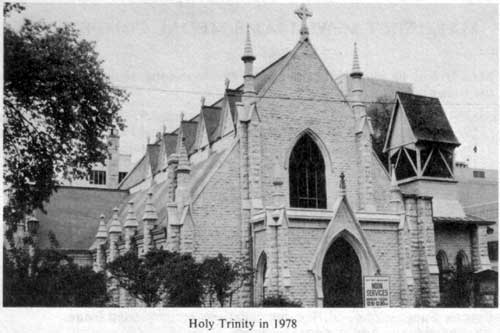Manitoba Pageant, Autumn 1978, Volume 24, Number 1
|
Holy Trinity Anglican Church, sandblasted and carefully cleaned, presents a bright new face to downtown Winnipeg today as it did when it opened ninety-four years ago. Located at Donald Street and Graham Avenue, “away out there” to the city’s early parishioners more familiar with Portage and Main, the Church stands on a lot bought for $1500 in the excitement of the 1880 land boom. Architect Charles H. Wheeler who had arrived from England in 1882 won the church design competition and the substantial prize of three hundred dollars. The sod for Winnipeg’s first Gothic church was turned in June, 1883. Bishop Robert Machray preached the first sermon in the new building on August 4, 1884 for the rector, Octave Fortin who had shepherded the lively congregation for the previous nine years. At the end of a long report on the opening, the Free Press observed that the church would become a great memorial to the architect.

The home which Wheeler built for himself at 62 Donald has been demolished, the treed lot left unoccupied as when he first saw it. Interior wood panelling, especially from the staircase, is held in storage. The house he designed for Sir Hugh John Macdonald proudly stands, saved and restored by the efforts of the Manitoba Historical Society. The Galt and Sanford warehouses on Princess Street, now featured in the Winnipeg Walk, also remain as examples of his work.
“If you would see his memorial, look about you,” says the brass inscription under the dome of St. Paul’s Cathedral. Christopher Wren is all about you as you pivot on that admired circle. Look about you, in Trinity, at the wondrous wooden roof, hammerbeamed, unsupported by pillars, and conjure up Charles Wheeler.
A man of many talents, he had worked as both an architect and a musician in Birmingham and London. In Winnipeg he continued both careers. He was organist and choirmaster of Knox Presbyterian and Zion Methodist churches and music and drama critic for the Tribune. He died in January, 1917 at seventy-eight years of age as a result of a fall on his way to review a play. The name of Charles H. Wheeler today appears only on his gravestone in St. James Cemetery. The name of his son, George Victor, is preserved on the Northwest Rebellion memorial column at the Centennial Centre.
In early photographs the bell tower and gables of Holy Trinity, not veiled by trees of later years, stand out stoutly facing the mansard-roofed Strevel house across Donald Street. This is a striking contrast to the view of the church today from the twenty-ninth floor of the Northstar Inn - a tiny model dropped from heaven amid skyscrapers.
Page revised: 20 July 2009